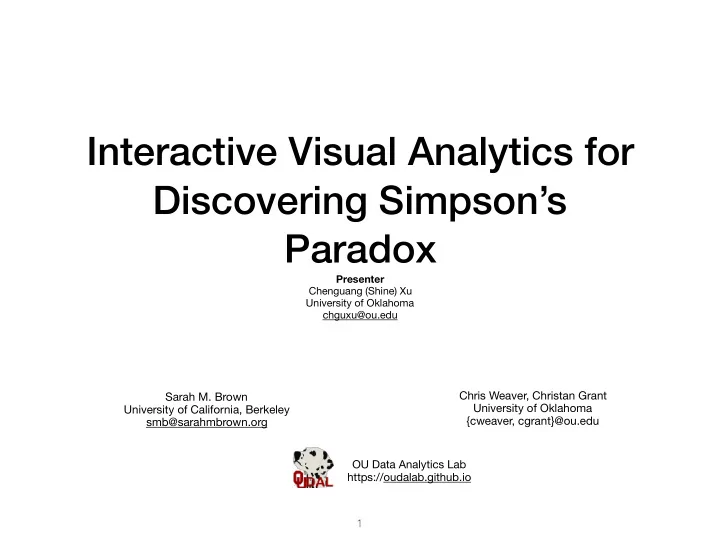

Interactive Visual Analytics for Discovering Simpson’s Paradox Presenter Chenguang (Shine) Xu University of Oklahoma chguxu@ou.edu Chris Weaver, Christan Grant Sarah M. Brown University of Oklahoma University of California, Berkeley {cweaver, cgrant}@ou.edu smb@sarahmbrown.org OU Data Analytics Lab https://oudalab.github.io � 1
Outline • Motivation • What is SP • Why detect SP • How to detect SP • Summary � 2
Motivation • Fairness forensics, investigate possible bias in data Looking for collaborators! https://fairnessforensics.github.io � 3
What is SP Simpson’s Paradox occurs when subgroups of a data set exhibit the opposite trend of the whole data set. • Regression-based SP • Rate-based SP � 4
Regression-based SP Kievit, Rogier A., et al. "Simpson's paradox in psychological science: a practical guide." Frontiers in psychology 4 (2013). � 5
Rate-based SP A study of gender bias among graduate school admissions to University of California, Berkeley, for the fall of 1973 https://en.wikipedia.org/wiki � 6
Why Detect SP Undetected SP can cause an unaware analyst to draw incorrect conclusions. � 7
Our Contribution Develop an interactive visual SP detecting website � 8
How to Detect SP • Visual technique: Bivariate color scheme • Interactive techniques: • Color Filtering • Interact from overview to detail � 9
Bivariate Color Scheme Step 1 Subgroup All Step 2 All Subgroup Subgroup All All Step 3 Subgroup Stevens, Joshua. Bivariate choropleth maps: A how-to guide. http:// www.joshuastevens.net/cartography/make-a-bivariate-choropleth-map/, 2015 � 10
Bivariate Color for SP SP SP � 11
Bivariate color selector � 12
Bivariate Color for Matrices Bivariate color for rate comparison matrices � 13
Bivariate Color for Matrices (cont.) Bivariate color for correlation matrices � 14
Color Filtering � 15
Overview to Details Interactive with slope graph for rate-based SP � 16
Overview to Details (cont.) Interactive with scatterplot for Regression SP � 17
Summary • Present an interactive interface that facilitates visual detection of SP • Introduce bivariate-scale heat maps to indicate subgroup-aggregate trend relationship • Explore SP from overview to details � 18
References [1] Armstrong, Zan and Wattenberg, Martin. Visualizing sta-tistical mix e ff ects and simpson’s paradox. IEEE trans-actions on visualization and computer graphics , 20(12):2132–2141, 2014 [2] Bickel, Peter J, Hammel, Eugene A, O’Connell, J William,et al. Sex bias in graduate admissions: Data from berkeley. Science , 187(4175):398–404, 1975. [3] Stevens,Joshua.Bivariatechoroplethmaps:Ahow-toguide.http://www.joshuastevens.net/ cartography/make-a-bivariate-choropleth-map/, 2015. [4] Trumbo, Bruce E. A theory for coloring bivariate statisticalmaps. The American Statistician , 35(4):220–226, 1981. [5] Xu, Chenguang, Brown, Sarah M, and Grant, Christan. De-tecting simpson’s paradox. AAAI, 2018. � 19
Question? � 20
Color Filtering � 21
Overview to Details • Interactive with slope graph for rate-based SP � 22
Overview to Details (cont.) • Interactive with scatterplot for Regression SP � 23
Recommend
More recommend